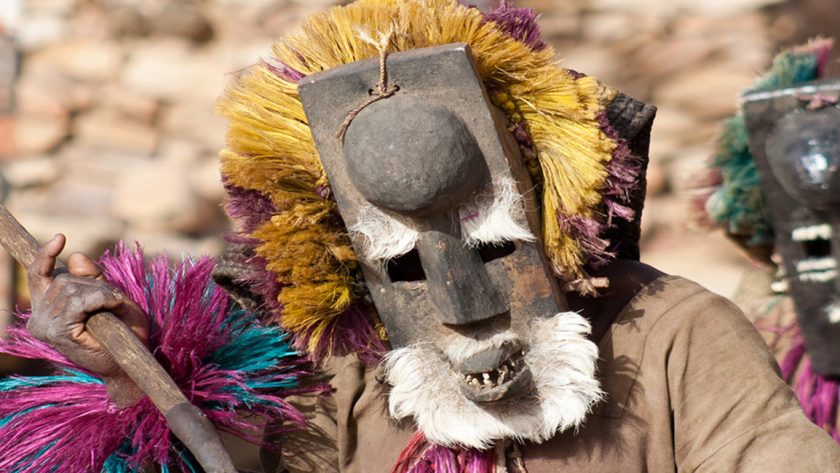It has been a long day of trekking through Dogon country–700 small villages scattered along a 100–mile stretch of central Mali’s Bandiagara Escarpment, reachable only by 4×4, donkey cart, and on foot–and my husband, Daniel, and I are ready for some rest. But instead of squeezing inside the mud–brick home of our Dogon hosts, we decide to sleep on the roof.
It may sound like an unusual choice, but it’s not. It’s possible to sleep inside, but most visitors choose the roof, as the Dogon people do in warm weather. It may be quite cold through the night, and a bit of a hard surface, but going to sleep under the stars, and waking to the sunrise over the rock cliffs, is more than worth it.
I climb to the rooftop first, so that Daniel can toss our backpacks up. The traditional Dogon ladder is hand–carved from a thick wooden log, not to mention slim and tricky to negotiate. Moreover, our home for the night is located beside a deep valley of rock, which is breathtaking to look at but scary when I contemplate losing my footing on the ladder. On the other side of the valley, an astounding vertical cliff rises several hundred feet above us.
Once on the rooftop, we can see the surrounding village, which sits high on the escarpment; all around is brown rock, with very few trees and little greenery. In the distance I can see women, buckets of water balanced confidently on their heads, returning from a nearby spring. Other houses constructed of mud and stone are nestled here and there among the craggy rocks.
We have brought warm clothes and purchased a piece of beautiful Malian mud cloth to keep us warm through the night. It’s not quite enough, though; it’s December, and the temperature plunges at night. The rooftop offers no protection from the wind, making the chill even more biting. One of the biggest challenges for visitors, however, is balancing the need for warmth and the need to travel light on the long walks each day. Despite the chill, I never even contemplate moving inside. The lack of electricity means that the thousands of stars in the sky are strikingly bright and visible.
Like most visitors to the area, we have traveled here accompanied by a guide. Guides are highly recommended in Dogon, and the best ones are Dogon themselves. A good guide knows the less–traveled paths and can share local stories and culture. Many travelers strike a deal with their guide in which he arranges for accommodation and food as well. When we first arrived in each village, we were led directly to our “campement,” and provided with a small mat to lay on the ground underneath our bedding–which we had to bring ourselves. In smaller villages and those that are harder to reach, Dogon families often provide shelter for the night.
In some villages, you can see the ancient dwellings of the Tellem, a people who ceased to exist in the sixteenth century, whose caves are located high on the vertical rock face and are impossible to reach today without serious ropes. As I lay my bedding down, I ponder these caves. One theory says that the wetter climate in the Tellem era may have allowed creeper vines to grow, providing natural ladders to ascend the cliff. Dogon legend, however, says the Tellem people could fly. Here in Dogon country, I can believe anything.
Lying awake, looking at the stars, I think about the great mystery of Sirius B. It’s a companion star to Sirius A, which is one of the brightest stars in the sky, but Sirius B is invisible to the human eye without a high–powered telescope. Astronomers had begun to suspect the presence of this white–dwarf star around the middle of the 19th century, and Western astronomers photographed it in 1862. Sirius A and B orbit each other once every 50 years; the Dogon’s most important festival, the Sigui, occurs about every 60 years, and some postulate it’s linked to the movement of these stars, though scientific and anthropological debates still rage. At each Sigui festival, a new ceremonial mask is carved especially for the occasion, then placed in the Tellem caves. Remnants of these masks going back hundreds of years have been found in the caves.
Morning seems to come quickly. As the sun rises, I wake a little stiff and tired, and spend a few extra minutes enjoying the fresh air and listening to the morning sounds of the village. I can hear clattering and chatting, and knowing breakfast is probably being prepared, we finally start to rise to pack the bedding. The air is already heating up. We head down from the rooftop, ready for a quick bite to eat and a Nescafé, then set off to begin another day of trekking.



